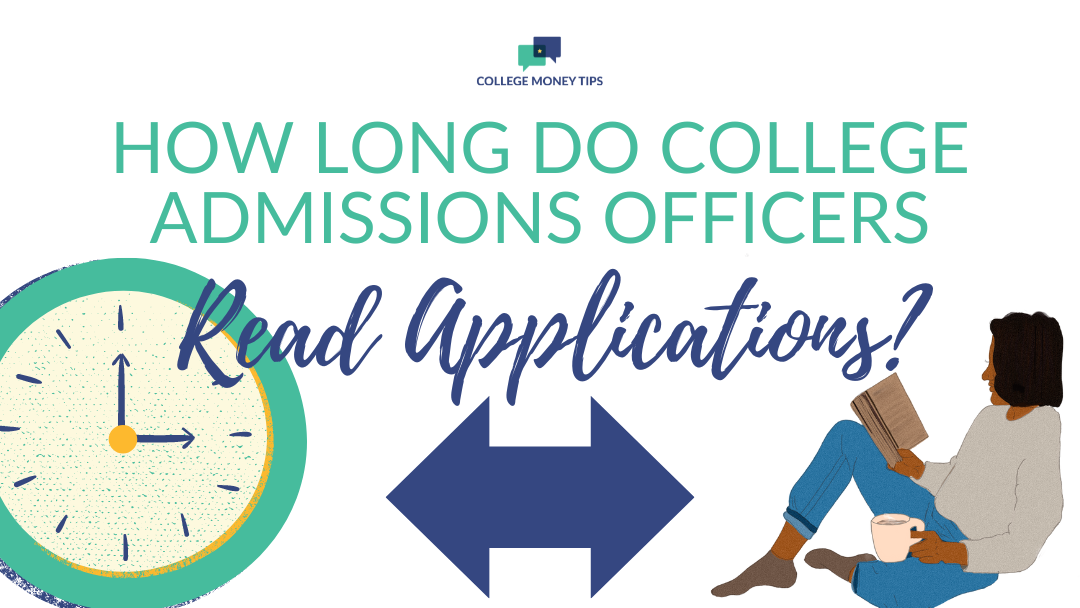How long do admissions officers read applications? More specifically, how much time do admissions officers spend on each application? You may wonder who sees your child’s application, how long they look at it and how they make a final decision.
The short answer is that it depends on the school, and a lot depends on the selectivity of the institution. All schools take a look at the application, but the rigor of the institution can dictate the amount of time spent reviewing it. For example, if your child applies to a highly selective institution, the application may go through at least two readers and a final committee. All told, between the first round of readers and the final committee, the application might get 15 minutes of attention from each round.
Admissions readers have a lot of applications to read and a finite amount of time to do it in, which is why your child’s application has to be a slam dunk.
In addition to answering the question, “how much time do admission readers spend on each application?”, we’ll also walk through where the application “goes” after it enters the college admissions process “tunnel.”
Contents
- What is Admissions Reading?
- The College Admissions Reading Process, Step by Step
- Step 1: The college screens and sorts applications.
- Step 2: Admissions readers read applications.
- Step 3: A committee takes a look at applications.
- Step 4: The final decision occurs.
- How to Get a Admission Reader’s Attention
- FAQs
- Do admissions officers read applications?
- How many essays do admissions officers read a day?
- Do admissions officers actually read essays?
What is Admissions Reading?
First of all, what exactly is admissions reading? During the admissions process, students apply for admissions at their top choice schools.
They may apply using the Common Application, the Coalition for College application, the Universal College Application, the college’s own application or another type of application process.
Once the application has been submitted, people take the time to review applications. Colleges often hire seasonal readers to work up to full time during what admissions professionals call “the reading season.” These admissions readers review prospective student test scores, transcripts, essays and other relevant admissions criteria to help make decisions about admissions candidates. Readers use a customer relationship management (CRM) system to manage the process. Students get admitted based on that particular college or university’s enrollment goals.
The College Admissions Reading Process, Step by StepLet’s take a look at the college admissions reading process, step by step, so you know what to expect. We’ll answer the question, “How do admissions officers read applications?” We’ll also touch on the amount of time admission readers take a look at the application.
Step 1: The college screens and sorts applications.
When the college receives a senior’s application, each college likely has a specific process for handling them. Many colleges import the information on the application and input it directly into the college’s CRM system.
(Fun fact: When I first started in admissions, our data team printed out the applications and checked them against the computer system — yes, we were still using physical files! Once our data team checked them over and ensured that the CRM matched the application, the file was ready to go onto the next step.)
The appropriate admissions officer will then receive the application. Admissions counselors have a region that they handle. For example, one admissions counselor will handle applications from the state of Colorado. If your student lives in Colorado, that admission counselor will handle your high schooler’s application.
Step 2: Admissions readers read applications.
Admissions readers then take on the process from there, usually in collaboration with the regional admissions counselor. How many admissions officers are there? It depends on the school, but admissions readers often work in pairs.
On the first pass, a new application may get a 10- to 15-minute review from that part-time hired application reader or another individual at the college or university. This leads to an understanding of the competitiveness of a candidate. Based on this first pass, they will give a recommendation about each candidate, entering in detailed information into the college’s CRM for each applicant. Admission readers may read 50 applications per day, moving methodically through a laid-out process.
Do admissions officers read all essays? The truth of the matter is that some schools have the application go directly to the final committee, whereas other (selective) colleges might read an applicant’s application again before it goes through the final phase.
Is this process subjective? Of course. Admission readers, while they have been trained in the requirements for admission to that particular institution, they obviously have biases and preferences when reviewing candidates for admission. A second or third round can offer another analysis and offer a more diversified view of the applicant. However, some universities, which have more qualitative processes, may push the applicant through to the “acceptance” stage without going through another round of reviews.
Step 3: A committee takes a look at applications.
Depending on the school, the college or university may not send applications to the “committee.” For colleges and universities that do send applicants to a committee, an official committee group may include a senior admissions official or two, an academic representative and other committee readers designated by the college or university. They will take a look at a rubric or notes in the CRM created by the reading process prior to the committee review.
This process will take about 15 minutes or so and a final decision will come out of the final committee meeting.
Step 4: The final decision occurs.
Once the process concludes, naturally, your student will get a final decision.
How long does it take to get a final decision? It depends on the type of admission at a particular college or university. Check out the eight different application types as well as a basic summary below:
- Regular admission: Regular admission deadlines typically occur in early January and admission offers are sent in late March or early April. Students will have to decide by May 1, the National Candidate Reply Day.
- Rolling admission: Students get an admission decision quickly, typically within two weeks, instead of sending out acceptances all on one date. Like regular admission, your student will need to decide whether to attend a “rolling admission” school by May 1.
- Open admission: Colleges accept high school graduates in the incoming class until all spaces fill up. Community colleges typically use this type of admission and you get a decision quickly.
- Early action: Early action, which is nonbinding, means your student has the option to submit an application before the regular deadline and you get a decision earlier than usual, typically in January or February.
- Early decision: Early decision is binding, which means you must attend that college. You typically apply early (usually in November) and usually get a decision by December.
- Single-choice early action or restrictive early action: This nonbinding option requires you to not apply to other schools during the early action period. You’ll apply early and hear back in December.
So, how long do colleges look at applications? Let’s take a look at it this way: How can you get an admission reader’s attention quickly? Consider that they may only spend 30 minutes total with your application from start to finish.
Get their attention by personalizing your application. Tell your own unique story in an engaging way. Many colleges request you to write supplemental essays. You can add intricate details about yourself through these supplementals. Here are a few examples:
Describe how you plan to pursue your academic interests and why you want to explore them at University X specifically. Please feel free to address your first- and second-choice major selections.
To tell us more about yourself, please complete the following sentences using only the space provided:
- If I could travel anywhere, I would go to…
- The most interesting fact I ever learned from research was…
- In addition to my major, my academic interests include…
- My favorite thing about last Wednesday was…
- When I think of diversity, I think of…
Something you might not know about me is… Describe the unique qualities that attract you to the specific undergraduate College or School (including preferred admission and dual degree programs) to which you are applying to University X. How would that curriculum support your interests?
Everyone belongs to many different communities and/or groups defined by (among other things) shared geography, religion, ethnicity, income, cuisine, interest, race, ideology or intellectual heritage. Choose one of the communities to which you belong, and describe that community and your place within it.
Prior to applying, it’s important to know the answer to “how long do colleges spend on each application?” It’s also important to figure out how to communicate your unique qualifications. Take every opportunity to convey exceptional talents, alumni legacies, how you will fit into the academic department that you are applying to and more.
If you’re curious about the admissions process at a particular college or university, you can ask. They may offer a detailed explanation or may also just give you a general explanation of how the admission process works.
FAQs
Do admissions officers read applications?
Yes, admissions officers do read applications. The admission office of a particular college or university may also hire remote or in-office seasonal readers to read applications during the admissions “reading season.”
That’s why it’s important for your student to put their best foot forward with the application — they should do the best they can to personalize the application, particularly with any supplemental essays required by the institution. This gives them an opportunity to showcase their unique personality and qualifications.
How many essays do admissions officers read a day?
Every admissions office has a goal for the number of essays that must be read during any given week. However, college admissions officers and admission readers may read approximately 50 applications per day, spending approximately 15 minutes per application.
Do admissions officers actually read essays?
Yes, admissions officers do actually read essays, but they might have already screened candidates first in a preliminary round. Every admissions office has a different process and it’s impossible to sum up the exact step-by-step process for each admission office in one blog post.


